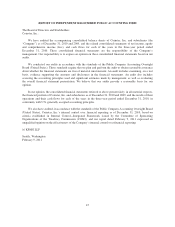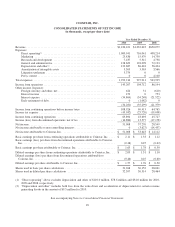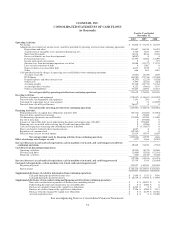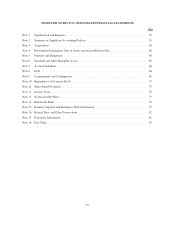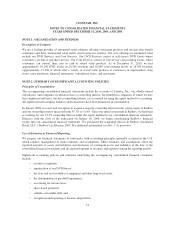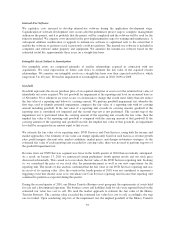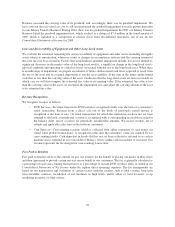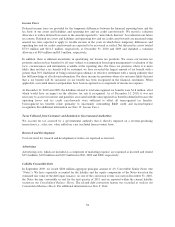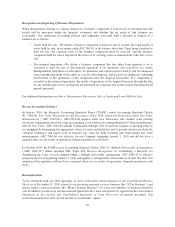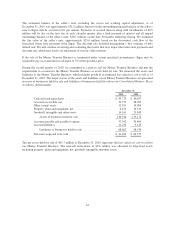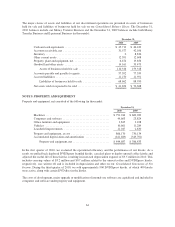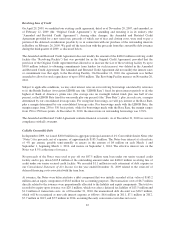Redbox 2010 Annual Report Download - page 65
Download and view the complete annual report
Please find page 65 of the 2010 Redbox annual report below. You can navigate through the pages in the report by either clicking on the pages listed below, or by using the keyword search tool below to find specific information within the annual report.Fair Value of Financial Instruments
The carrying amounts for cash and cash equivalents, our receivables and our payables approximate fair value,
which is the amount for which the instrument could be exchanged in a current transaction between willing
parties. Our available-for-sale securities are marked to fair value on a quarterly basis. The fair value of our
revolving line of credit approximates its carrying amount. For additional information see Note 18: Fair Value.
Foreign Currency Translation
The functional currencies of our international subsidiaries are the British pound Sterling for our subsidiary
Coinstar Limited in the United Kingdom, Canadian dollar for Coinstar International, and the Euro for our
subsidiaries Coinstar Money Transfer and Coinstar Ireland Limited. We translate assets and liabilities related to
these operations to U.S. dollars at the exchange rate in effect at the date of the Consolidated Balance Sheets;we
convert revenues and expenses into U.S. dollars using the average monthly exchange rates. Translation gains and
losses are reported as a separate component of accumulated other comprehensive income.
Interest Rate Swap
At December 31, 2010, we had one interest rate swap outstanding that was accounted for as a cash flow hedge.
Accordingly, unrealized gains and losses are recorded as a component of other comprehensive income, net of tax,
with the corresponding adjustment to other accrued liabilities in our consolidated financial statements. As of
December 31, 2010 and 2009, other accrued liabilities included $0.9 million and $5.4 million, respectively,
related to the fair value of interest rate swaps. We reclassify a corresponding amount from accumulated other
comprehensive income to interest expense in the Consolidated Statements of Net Income as the interest payments
are made.
One of our risk management objectives and strategies is to lessen the exposure of variability in cash flow due to
the fluctuation of market interest rates and lock in an interest rate for the interest cash outflows on our revolving
debt. We do not engage in interest rate speculation using derivative instruments. For additional information see
Note 17: Derivative Instruments and Note 18: Fair Value.
Share-Based Payments
We measure and recognize compensation expense for all share-based payment awards granted to our employees
and directors, including employee stock options and restricted stock awards based on the estimated fair value of
the award on the grant date. We utilize the Black-Scholes-Merton (“BSM”) valuation model for valuing our stock
option awards and the determination of the expenses.
The use of the BSM valuation model to estimate the fair value of stock option awards requires us to make
judgments on assumptions regarding the risk-free interest rate, expected dividend yield, expected term and
expected volatility over the expected term of the award. The assumptions used in calculating the fair value of
share-based payment awards represent management’s best estimates at the time they are made, but these
estimates involve inherent uncertainties and the determination of expense could be materially different in the
future.
We amortize share-based compensation expense on a straight-line basis over the vesting period of the individual
award with estimated forfeitures considered. Vesting periods are generally four years. Shares to be issued upon
the exercise of stock options will come from newly issued shares.
Share-based compensation expense is only recognized on awards that ultimately vest. Therefore, we have reduced
the share-based compensation expense to be recognized over the vesting period for anticipated future
forfeitures. Forfeiture estimates are based on historical forfeiture patterns. We review and assess our forfeiture
estimates quarterly and update them if necessary. Any changes to accumulated share-based compensation expense
are recognized in the period of change. If actual forfeitures differ significantly from our estimates, our results of
operations could be materially impacted. For additional information see Note 11: Share-Based Payments.
57


